Introduction.
1987 MC16
1988 MC18 R2/4J
1989 MC18 R5/6K | wire splice
1990~1993 MC21 | wire splice
1994~ MC28 | wire splice
The NSR 250 leaves the Honda factory with only a stifled 40-45hp (depending on model), but was always destined by it's designers to be so much more, indicated by the flat slide Keihin carburettors, optional dry clutch [from 1989 onwards], and port timing!
So, although any NSR model is a terrific motorcycle in its own right, it can be vastly improved by modifying a number of its components. As listed in the index, all of the major systems can be upgraded, each adding to a final package that can produce a highly enjoyable and satisfying riding experience!
| Note: | Throughout this guide, where base settings are provided, these have been provided by each manufacturer & are a guideline only. |
Genuine HRC parts are often referred to as 'kit parts'; parts from tuning companies like TYGA, Jha, Ethos, and M-Max etc. are referred to as 'aftermarket parts'.
Each modification will have positive effect on performance, and generally it doesn't matter in which order they are carried out. Be aware though that not all modifications or manufacturers are equal, and some modifications often perceived as being beneficial are not simple "bolt-on" upgrades, and can actually harm performance. One such misconception is the use of an RS250 NF5 ignition module. The first job without a doubt is to lift the speed/ignition restriction.
The MC16 is not electronically speed limited, but as a sign of the times, it's output is limited by it's porting, small carburettors, restricted airbox and early twin CDI ignition. Unless disabled, the only excess speed indication is in the form of a warning light that will illuminate on the speedometer. [top]
Speed restriction: 1988 MC18 R2J / R4J (PGM-I)
Speed restriction became law in Japan in 1988.
MC18 MkI's [R2J & R4J] were speed restricted by limiting the opening of the RC Valve, which is a very simple restriction that is easily bypassed! Not only is derestriction on these bikes free, but once completed, there will be a horse-power gain too! What more could you want?!
By limiting the amount the RC Valve is allowed to open, it consequently reduces the power output to around 45hp, which in turn is approximately the HP needed to get an MC18 to around 110-115mph! Simple but effective!
To delimit the MC18R2J/R4J harness, remove the seat unit and locate the red connector as shown in the image below.
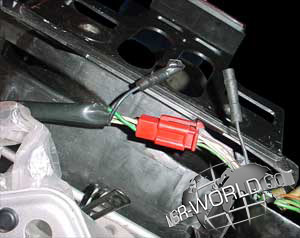
Look for the black/blue wire with the "bullet" type connection. Pull the connector apart and tape up the male end to prevent it shorting on the seat subframe and you're done! Like we said - simple!! Now, instead of of the motor falling flat at 10,000rpm (despite how carefully you have set the RC Valves up!), it will pull right through to the red in every gear! A little careful jetting and maybe a change of final drive ratio should see top speed increased to a little over 120mph and power up towards the 60hp mark!! [top]
Speed and ignition restriction: 1989 MC18 R5K / R6K (PGM-II)
The MC18R5K/R6K is restricted by the infamous Honda orange/blue wire! This system is used on countless JDM Honda models, and even some world market models. (More notable cases are the RVF750 RC45 and the NR750.)
To delimit the MC18 R5/6K PGM-II, locate the orange/blue wire coming out of the PGM-II unit, and splice it into the black/white wire as per the MC21 wire splice instructions later on this page.
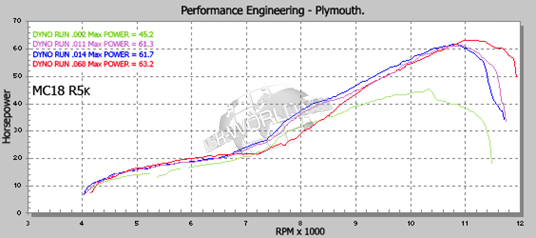
The above dynographs show an MC18 R5K in various states of tune.
- The Green trace (45.2hp) illustrates a completely stock bike as a base-line to assess modifications against.
- The purple trace (61.3) shows what can be attained with nothing more than the wiring modification and some careful jetting - some 15 horsepower!
- The blue trace (61.7hp) sees the bike equipped with race cans, a modified airbox, and some more jetting changes to account for the increased gas-flow.
- The final run is shown by the red trace (63.2hp) and shows the difference between race pipes and stock pipes.*
*Although the stock MC18's expansion chambers are very good (Honda saw fit to only make them quiet, and not restrict them very much) the race pipes add 1.5hp at the top-end and also 500rpm of healthy over-rev. This is great on the track or down the pub, but the stock pipes really score heavily over the race pipes in the mid-range, producing around an extra 9hp more than the race pipes at 8000rpm! [top]
Speed and ignition restriction: 1990~1993 MC21 (PGM-III)
There are many makes of speed derestrictor on the market for the MC21, the most common is undeniably manufactured by M-Max. The NSR is restricted in 4th, 5th and 6th gear by a program in the PGM-III (ECU, or electronic control unit) activated by a GPS (gear position sensor). This detects the top three gears and when the road speed reaches 180kph (112mph), limits the ignition advance, causing the power to tail off. The M-Max box claims to disable the sensor and allow the PGM to provide the optimum setting, but in reality it's all smoke and mirrors! The M-Max delimiter is nothing more than an expensive wiresplice, and the G.P.S. connectors do nothing more than loop around inside the plastic casing!
HRC sell a 'kit' part (MC21 part# 30490-NKD-840) that will only plug into an HRC race harness. Although the harness and delimiter are now discontinued, NOS (new old stock) can still be found online from various outlets, but the cost these days is soaring! [top]
Speed derestriction: MC28 "Swipe Card" (PGM-IV)
The MC28 was unique in it's day as a 250, being the first to sport a digital display, and the first and only 250 2-stroke road bike ever to sport a single sided swingarm! It suffered a similar problem to the TZR250 3XV V-twin though, in that it was a lot more difficult to derestrict than its predecessors, but due to the NSR's popularity and effectively, simplicity, it was never quite the 'lemon' the Yamaha was!
The "Swipe Card" system was initially promoted by Honda as a leap forward in tuning potential, with the availability of different cards for different tracks and riding conditions. What they had really done was cleverly disguised an ignition restriction that was virtually impossible to bypass. Then, for added security, coded full power cards to not work if the PGM-IV detects "road equipment" still fitted. Honda then made the HRC cards available only to purchasers of the HRC wiring loom, for which, just to make things even more difficult, required a race licence to buy!!
| Note: | A popular misconception regarding delimiting the MC28 is that you can simply
buy an HRC card for the ignition. Unfortunately this 100% urban legend! |
Although 3 different cards were originally available (1 stock, and 2 HRC), the 2 HRC cards could only be used effectively in conjunction with the HRC wiring loom (part# 32100-NKD-970). The HRC loom has no provision for road riding equipment. The lights, indicators (turn signals), brake light, oil, side stand, and neutral warning lights are all removed. The speedo is also disabled and the display converted to a large format temperature gauge.
The 2 original HRC cards have now been replaced with an "all-purpose" 030 version.
The 4 cards are designated as follows:

| Note: | Any new card (HRC or stock) needs to be coded to the particular PGM unit that it is to be used with for security reasons. Coding is done by Honda when purchasing the card, by providing them with the 4-digit PIN on the cover of the PGM-IV. Re-coding services are now also available in Japan. The service requires the PGM-IV and card(s) to be sent to a vendor in Japan, and can take up to 6 weeks. Cost for this service is approximately 25,000 Yen. |
The HRC cards can now be bought separately from the HRC loom, and although their effectiveness in conjunction with an otherwise stock bike is questionable, they will allow a slight increase in power once expansion chambers are fitted and the carb's are re-jetted.
In 1994 HRC introduced a new flywheel and stator (part# 31100-NKD-970). The benefit of this was a more compact design, and hence, lighter weight. Less weight meant less resistance to inertia and a "snappier" throttle response, but at the expense of a little (although already virtually non-existent!!) torque. Bought separately, the cost of this item is rather unjustifiable at ¥200,000 or £1000 ($1500) for all but the professionally rich!!![top]
Lightened flywheels for race use only are available from the NSR-WORLD.COM Marketplace!
| Note: | It is not recommended to use the MC21 flywheel on the MC28 |
Spark Plugs.
HRC specify short reach plugs for a race set-up for both the MC21 and MC28. They will also work for the MC18. These plugs are RS250 items and come in either 10 or 10.5 heat range, and the part numbers for these are 31930-ND5-003 and 31940-ND5-003 respectively. Special caps need to be used with these plugs (part# 30700-ND5-751). After removing the old caps trim 5mm from the HT leads before fitting the new ones to ensure a good reliable connection.
Wire Splices.
The MC18, MC21, and MC28 wiring harnesses can be delimited with a "wire splice". Although an extremely effective and cheap alternative to the HRC solution, it only delimits the ignition on the 1989 MC18 R5/6K and 90~93 MC21 "Gull-Arm". The wire-splice for the MC28 "Pro-Arm" only allows the use of an HRC card without an HRC race harness. Without the HRC card however, there is no point in performing the splice, as the the ignition "program" contained in a standard card is still just that -- standard!
The wire splices give you the benefit of using all of the road-going equipment on the MC18 R5/6K and MC21, and most of it on the MC28!
NSR250 MC18 R5/6K and NSR250 MC21 Wire Splice.
| Note: | Although the 1990~1993 MC21 PGM-III is shown in this guide, the proceedure is exactly the same for the 1989 MC18 R5K/R6K-SP. |
To gain full OEM power on the MC21 the "wire splice" needs to be performed. This disables the ignition limiter in 4th, 5th, and 6th gear. Although a stock NSR will rev in these higher gears, the restricted ignition prevents it from making any useable power and therefore acts as an electronic speed limiter. The offending wire in this restriction is the 'legendry' orange and blue (O/Bu) wire! In the OEM configuration it is routed to earth (ground), but to delimit the ignition it needs to be powered by 12V.
Follow these 10 simple steps to unleash free horsepower!!
| Note: | The first colour in the wire code is the primary wire colour, and the second colour is the "tracer", the thin line running along its length. |
- Ensure the ignition is off, and disconnect the battery.
- Unplug the black and white connectors from the PGM-III and remove the insulation from the black connector to expose as much wire as possible.
- Separate the orange/blue (O/Bu) and black/white (Bk/W) wires from the rest.
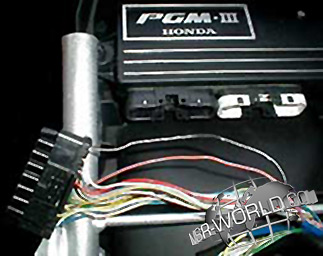
- Snip the O/Bu wire approximately 70mm from the black connector, and on the connector side, remove 5mm of insulation to expose the copper core inside.
- At the same distance from the connector, remove 8mm of insulation from the Bk/W wire.
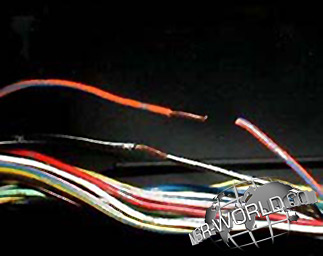
Do not cut the Bk/W wire, only remove its insulation.
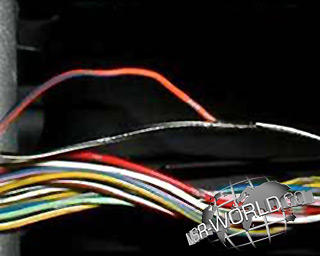
- Solder the O/Bu wire to the Bk/W wire. Use plenty of soldering flux to ensure a perfect connection.
- Insulate the soldered connection, and also the bare end of the snipped O/Bu wire with insulation tape or better still, heatshrink.
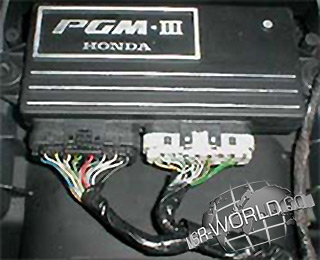
- Wrap all the wires back up with insulation tape, and no-one will ever know the difference.
- Plug the black and white connectors back into the PGM unit
- Reconnect the battery, and the job is done. [top]
Jha will modify a standard loom to accept an HRC card, but unfortunately this service is currently only available to customers who can deliver their bike to Jha's workshop. This can be more than a little inconvenient for the majority of current owners, we're sure you'll agree, so the following section details how to modify your stock harness to accept an HRC card.
The advantage of this modification over the HRC wiring harness is that most of the stock electrical systems will still function. (i.e. lights, indicators, horn, etc.)
- Unplug the black and white connectors from the PGM-IV and remove the insulation from the black connector to expose as much wire as possible.
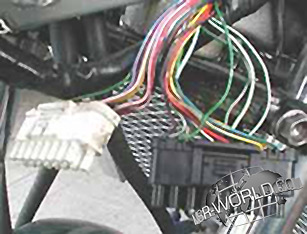
- Now separate the following wires from the rest: Green (earth), Light Green/Red (neutral switch), Green/Pink (oil level indicator), Green/White (side stand switch).
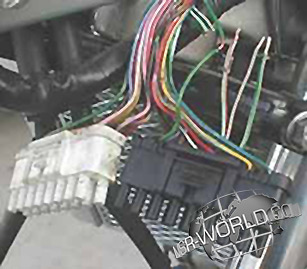
- Snip the LtGn/R, Gn/P & Gn/W wires approximately 60mm from the black connector, and remove 5mm of insulation to expose the copper wires inside.
- At the same distance from the connector, remove 5~10mm of insulation from the solid green earth wire.
Do not cut the Green wire, only remove its insulation.
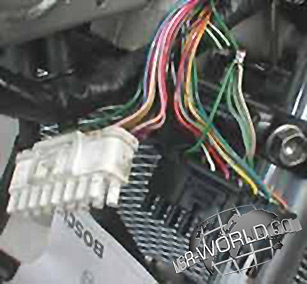
- Solder the three snipped wires to the green (earth) wire. Use plenty of soldering flux to ensure a perfect connection.
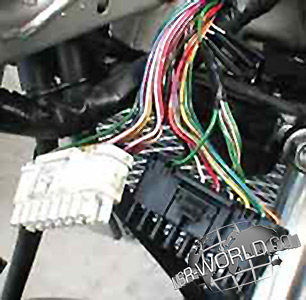
- Insulate the soldered connection, and also the bare ends of the snipped wires with insulation tape or better still, heatshrink.
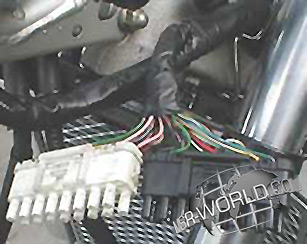
- Wrap all the wire back up with insulation tape, and no-one will ever know the difference.
- Plug everything back together, and the job is done. [top]
Special thanks to TYGA Performance for the detailed overview & pictures of the MC28 wire splice.

